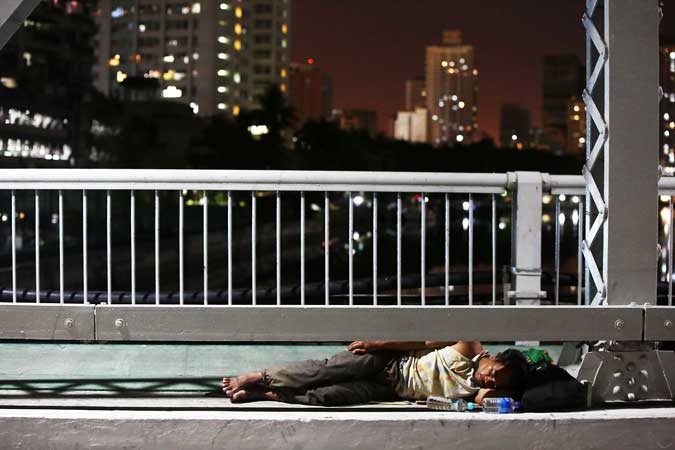
THE government scaled down its ambitious goals to reduce poverty and unemployment by 2022, as the coronavirus pandemic reversed any gains that were made in recent years.
The updated Philippine Development Plan 2017-2022 (PDP), released on Thursday, showed the government is now targeting to cut the poverty rate to 15.5-17.5% this year.
The initial goal was to bring down poverty incidence to 14% by 2022. Before the pandemic hit, the Philippines appeared on track to achieve this target as poverty incidence, or the proportion of Filipinos whose incomes fell below the poverty line, fell to 16.7% in 2018, from 23.5% in 2015.
The World Bank estimated nearly three million Filipinos may have slipped into poverty last year.
The National Economic and Development Authority (NEDA) reviewed the targets under the PDP in light of the impact of COVID-19 on the economy.
“The immediate socioeconomic impact of the pandemic in 2020 is substantial. This will most likely spillover to 2021 and 2022. Taking this into consideration, some targets for 2021 and 2022 have been revised downwards. Since the updating of the PDP happened in the second half of 2020, the targets for 2020 were maintained,” the report read.
The government now aims to bring down the unemployment rate to 7-9% this year and 2022. The jobless rate averaged 10.2% in 2020 as businesses laid off workers during the height of the strict lockdown.
The previous goal was to reduce the unemployment rate to 3-5% by 2022.
In a press briefing on Thursday, Acting Socioeconomic Secretary Karl Kendrick T. Chua said the pandemic’s blow on the labor market should improve next year, but the overall unemployment rate will remain elevated given the expected surge in new workers when the first batch of graduates that completed the K to 12 program join the workforce.
Among the youth, the unemployment rate is expected to spike to 14.5-16.5% this year and further to 20.5-22.5% in 2022. The previous goal was to reduce the youth jobless rate to 8.6% this year and 8% by 2022.
The NEDA estimated youth jobless rate went down to 9.2% last year from 2019’s 9.8%.
“We know that it will still be a very difficult labor market situation but this one is also to tell us that we will need more social protection and it will still be a challenging employment situation. We think for 2021 and even 2022, it’s still about transforming the workforce so that they are ready for the challenges in the new normal,” NEDA Undersecretary Rosemarie G. Edillon said.
Under the updated PDP, the government abandoned the previous target of a 7-8% annual economic growth through 2022. Instead, it adopted a lower target range of 6.5-7.5% until next year.
Ms. Edillon clarified that the 8-10% growth the Development Budget Coordination Committee (DBCC) projected in December meant the government is likely to beat the revised target under the PDP.
The target growth rate for gross national income (GNI) per capita was also downgraded to 5-6% from the initial goal of 5.2%.
At the same time, the government kept its goal of attaining the upper middle-income status “by 2022 or earlier.”
Latest World Bank data showed the Philippines remained as a lower-middle income economy in 2019 with a GNI per capita of $3,850.
Meanwhile, the target food inflation rate was retained at 2-4%.
The government still aims to improve its ranking in the Human Development Index (HDI) and Global Innovation Index (GII) in the next two years. It hopes to land on the top one-third in the GII ranking.
Last year, the Philippines saw its HDI score increase to 0.718 and moved up four places to 50th out of 131 economies in the GII.
“The medium-term goal remains the same: by the end of 2022, more Filipinos will be closer to their AmBisyon of living a matatag, maginhawa, at panatag na buhay. The health and resilience of the Filipinos will be prioritized in the medium term as the foundation to achieving this aspiration,” the report said.
Ms. Edillon said the remaining two years of the Duterte administration will be focused on building economic recovery and resilience.
To boost resilience, she said the PDP laid out five major programs under the new normal, namely: health system improvement, food security, learning continuity, digital transformation, and regional development through the Balik Probinsya Bagong Pag-asa Program.
“The updated PDP also identified reforms to increase FDI (foreign direct investments), ease human capital constraints, improve government over the management of resources and the environment, and expand market linkages for MSMEs (micro-, small- and medium-sized enterprises),” she added.
Further, she said the updated roadmap included an reintegration program to assist overseas Filipino workers and their families.
PDP is the country’s first medium-term roadmap out of the four plans towards the long-term vision of Ambisyon 2040 where the Philippines is dominantly a middle-income society and no one is poor.
“Twenty years until 2040 is a long time and many challenges may come at any time. It is important to quickly recover those lost ground and ensure sustainability of the gains by building resilience then get back on track towards Ambisyon 2040,” Ms. Edillon said.
During the press conference, former NEDA chief Ernesto M. Pernia said the government should ramp up spending to support the economy’s recovery. — Beatrice M. Laforga


